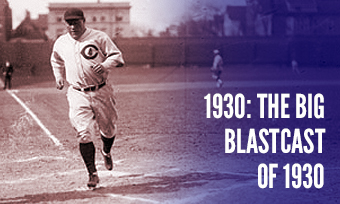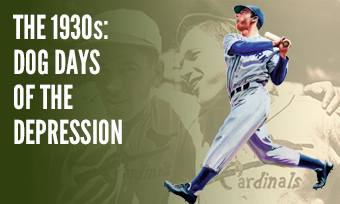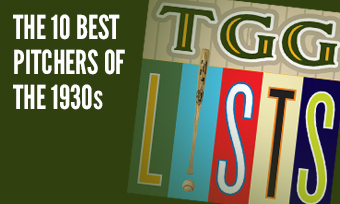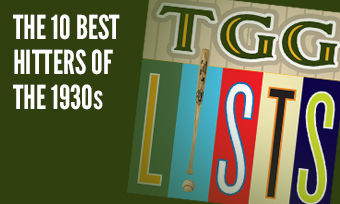The Yearly Reader
Leaders and Honors, 1930
Our list of baseball’s top 10 hitters and pitchers in both the American League and National League for the 1930 baseball season, as well as the awards and honors given to the game’s top achievers of the year.
The National League’s Top 10 Hitters, 1930
Bold type in brick red indicates league leader.
1. Hack Wilson, Chicago
Key Numbers: .356 average, 146 runs, 208 hits, 35 doubles, 6 triples, 56 home runs, 191 RBIs, 105 walks, 84 strikeouts, .723 slugging percentage.
Get this: From August 1 on alone, Wilson drove in 100 runs.
2. Chuck Klein, Philadelphia
Key Numbers: 156 games, .386 average, 158 runs, 250 hits, 59 doubles, 8 triples, 40 home runs, 170 RBIs.
Klein’s 170 RBIs are the second most all-time by a National Leaguer—and the second most in 1930. He wasn’t about to miss a minute of this batting bonanza, playing every inning but one—after he was tossed late from a game.
3. Babe Herman, Brooklyn
Key Numbers: .393 average, 143 runs, 241 hits, 48 doubles, 11 triples, 35 home runs, 130 RBIs, 66 walks, 18 stolen bases, 13 caught stealing.
A late-August slump dropped Herman below .400, into the .380s; he never recovered enough to reclaim it, preventing the NL from seeing two players end the year over the hallowed mark. His 35 games with three or more hits set an NL record.
4. Kiki Cuyler, Chicago
Key Numbers: 156 games, .355 average, 155 runs, 228 hits, 50 doubles, 17 triples, 13 home runs, 134 RBIs, 72 walk, 10 hit-by-pitches, 37 stolen bases.
Cuyler had the kind of numbers that reminded many of his breakout 1925 season—but as you’re seeing, a lot of players had those kind of numbers in 1930. He also became the first (and still only) player to score four runs in a game four times in multiple seasons.
5. Bill Terry, New York
Key Numbers: .401 average, 139 runs, 254 hits, 39 doubles, 15 triples, 23 home runs, 129 RBIs.
Bill Terry produced the last NL .400 average to date—and needed just two bats all year to do it.
6. Mel Ott, New York
Key Numbers: .349 average, 122 runs, 182 hits, 34 doubles, 25 home runs, 119 RBIs, 103 walks, 20 sacrifice hits, .458 on-base percentage.
Strangely, Ott’s home run numbers tumbled from the year before from 42—and he was especially light on the road, hitting just four jacks all season away from the Polo Grounds.
7. Chick Hafey, St. Louis
Key Numbers: 120 games, .336 average, 108 runs, 150 hits, 39 doubles, 12 triples, 26 home runs, 107 RBIs, 12 stolen bases.
Missing out on 30 games kept Hafey from increasing his numbers to those listed above.
8. Lefty O’Doul, Philadelphia
Key Numbers: .383 average, 122 runs, 202 hits, 37 doubles, 7 triples, 22 home runs, 97 RBIs, 63 walks.
Various injuries all but sidelined O’Doul in September—yet he remained effective thanks to a potent pinch-hitting run.
9. Freddie Lindstrom, New York
Key Numbers: .379 average, 127 runs, 231 hits, 39 doubles, 7 triples, 22 home runs, 106 RBIs, 15 stolen bases.
Lindstrom collected 231 hits for the second time in three seasons; only four other players (George Sisler, Rogers Hornsby, Paul Waner and Ichiro Suuzki) have managed to collect as many twice.
10. Wally Berger, Boston
Key Numbers: .310 average, 98 runs, 27 doubles, 14 triples, 38 home runs, 119 RBIs.
The 24-year-old rookie, fresh off a 40-homer campaign for the Pacific Coast League’s Los Angeles Angels, didn’t appear to be any less impressed by the majors’ state of pitching as he set a first-year home run record that would stand on its own until Frank Robinson tied it in 1956.
The American League’s Top 10 Hitters, 1930
1. Lou Gehrig, New York
Key Numbers: 154 games, .379 average, 143 runs, 220 hits, 42 doubles, 17 triples, 41 home runs, 173 RBIs, 101 walks.
Gehrig continued to be every bit as effective as Babe Ruth, initiating an eight-year stretch in which he would average 155 RBIs; four times in 1930, he drove in six runs to set an MLB record that still stands.
2. Al Simmons, Philadelphia
Key Numbers: .381 average, 152 runs, 211 hits, 41 doubles, 16 triples, 36 home runs, 165 RBIs.
Of Simmons’ career-best 36 homers, 25 were hit at Shibe Park.
3. Babe Ruth, New York
Key Numbers: .359 average, 150 runs, 49 home runs, 153 RBIs, 136 walks, .493 on-base percentage, .732 slugging percentage.
Ruth was twice robbed of home runs by a speaker above the right field wall at Philadelphia that kept him from reaching 50 on the year.
4. Jimmie Foxx, Philadelphia
Key Numbers: .335 average, 127 runs, 33 doubles, 13 triples, 37 home runs, 156 RBIs, 93 walks, 66 strikeouts.
Foxx began a decade in which he would lead all major leaguers with 415 homers.
5. Eddie Morgan, Cleveland
Key Numbers: .349 average, 122 runs, 204 hits, 47 doubles, 11 triples, 26 home runs, 136 RBIs, 62 walks.
Morgan took over for injured, reigning AL batting champ Lew Fonseca at first base and briefly made everyone forget about him.
6. Joe Cronin, Washington
Key Numbers: 154 games, .346 average, 127 runs, 203 hits, 41 doubles, 9 triples, 13 home runs, 126 RBIs, 72 walks, 17 stolen bases.
Cast adrift by a hard-hitting Pirates team that couldn’t find a spot for him, Cronin made Pittsburgh think twice as he emerged as a premier shortstop at Washington.
7. Goose Goslin, Washington-St. Louis
Key Numbers: .308 average, 115 runs, 36 doubles, 12 triples, 37 home runs, 138 RBIs, 67 walks, 17 stolen bases.
Traded to the Browns, Goslin finally got the chance to show his true power on a home field where the fences weren’t set back to the next county.
8. Charlie Gehringer, Detroit
Key Numbers: 154 games, .330 average, 144 runs, 201 hits, 47 doubles, 15 triples, 16 home runs, 98 RBIs, 69 walks, 19 stolen bases, 15 caught stealing.
Gehringer set a career high in runs; Dale Alexander was second on the team with 58 fewer platings.
9. Carl Reynolds, Chicago
Key Numbers: .359 average, 103 runs, 202 hits, 25 doubles, 18 triples, 22 home runs, 104 RBIs, 16 stolen bases.
Three of Reynolds’ career-high 22 home runs came in consecutive at-bats to tie a major league record.
10. Earl Averill, Cleveland
Key Numbers: .339 average, 102 runs, 181 hits, 33 doubles, 8 triples, 19 home runs, 119 RBIs.
There was no sophomore slump for Averill, who by and large matched his rookie numbers.
The National League’s Top 10 Pitchers, 1930
1. Dazzy Vance, Brooklyn
Key Numbers: 2.61 ERA, 17 wins, 15 losses, 4 shutouts, 258.2 innings, 55 walks.
Owner of baseball’s lowest opposing batting average (.246), Vance also won the hard-luck award for managing a record barely above the .500 mark.
2. Carl Hubbell, New York
Key Numbers: 3.87 ERA, 17 wins, 12 losses, 37 appearances, 32 starts, 241.2 innings, 11 hit-by-pitches.
In a year like this, you could bend King Carl—but you couldn’t break him.
3. Pat Malone, Chicago
Key Numbers: 3.94 ERA, 20 wins, 9 losses, 45 appearances, 35 starts, 22 complete games, 271.2 innings.
Congrats to Malone, the NL’s only 20-game winner with an ERA below 5.00.
4. Bill Walker, New York
Key Numbers: 3.93 ERA, 17 wins, 15 losses, 39 appearances, 34 starts, 245.1 innings.
Sandwiched between two NL ERA crowns, Bill Walker was just happy to keep his batter-fatigued ERA under 4.00 in 1930.
5. Watty Clark, Brooklyn
Key Numbers: 4.18 ERA, 13 wins, 13 losses, 7 saves, 44 appearances, 24 starts, 200 innings, 38 walks.
The Louisiana southpaw nearly pulled off the impossible—throwing a no-hitter in a season gone offensively mad—as he produced the majors’ lone one-hit shutout on the year in July against Pittsburgh.
6. Freddie Fitzsimmons, New York
Key Numbers: 4.25 ERA, 19 wins, 7 losses, .731 win percentage, 41 appearances, 29 starts.
Fitzsimmons’ ERA was as high as 6.64 on July 23 before going 11-2 with a 2.35 figure thereafter.
7. Jumbo Elliott, Brooklyn
Key Numbers: 3.95 ERA, 10 wins, 7 losses.
Mostly a failure coming into the season with a 16-31 record over four previous campaigns for the Robins, the 6’3”, 235-pound lefty managed to hold his weight in success amid, ironically, a year as hitter-crazed as this one.
8. Charlie Root, Chicago
Key Numbers: 4.33 ERA, 16 wins 14 losses, 37 appearances, 30 starts, 15 complete games, 4 shutouts, 220.1 innings, 124 strikeouts.
A bum shoulder over the season’s final month-plus kept Root from obtaining 20 wins—and possibly kept the Cubs from winning the pennant.
9. Socks Seibold, Boston
Key Numbers: 4.12 ERA, 15 wins, 16 losses, 36 appearances, 33 starts, 251 innings.
Once a youthful member of the awful A’s teams of the mid-1910s before disappearing from the major league scene for most of the 1920s, Seibold’s second year at Boston was his staunchest yet, even if his record didn’t show it.
10. Roy Kolp, Cincinnati
Key Numbers: 4.22 ERA, 7 wins, 12 losses, 168.1 innings, 34 walks.
The veteran hybrid starter/reliever, better known for his colorful bench jockeying that drove opponents mad—or absolutely deranged, as in the case of Hack Wilson in 1929—had to wonder how the Cubs’ Guy Bush finished 15-10 with an ERA two full runs worse.
The American League’s Top 10 Pitchers, 1930
1. Lefty Grove, Philadelphia
Key Numbers: 2.54 ERA, 28 wins, 5 losses, .848 win percentage, 9 saves, 50 appearances, 32 starts, 291 innings, 60 walks, 209 strikeouts.
Grove appeared to be the only pitcher stuck in time, throwing like it was 1909.
2. Wes Ferrell, Cleveland
Key Numbers: 3.31 ERA, 25 wins, 13 losses, 43 appearances, 35 starts, 25 complete games, 296.2 innings.
When your ERA is this low in a year like 1930, 25 wins should be a cinch; 16 of them came at home.
3. Ted Lyons, Chicago
Key Numbers: 3.78 ERA, 22 wins, 15 losses, 42 appearances, 36 starts, 29 complete games, 297.2 innings, 57 walks.
The first half of Lyons’ 21-year career peaked, a year before arm troubles made him rely more on a knuckleball to extend his major league lifespan.
4. Bump Hadley, Washington
Key Numbers: 3.73 ERA, 15 wins, 11 losses, 42 appearances, 34 starts, 260.1 innings.
Oddly, Hadley had one of his more efficient seasons in a year where pitchers seemed to be highly handicapped by a very live ball.
5. Lefty Stewart, St. Louis
Key Numbers: 3.45 ERA, 20 wins, 12 losses, 271 innings.
Just happy to be around after nearly dying of appendix problems in 1927, Stewart had the second-best ERA by a player named Lefty—and third best in the AL, regardless of name.
6. Milt Gaston, Boston
Key Numbers: 3.92 ERA, 13 wins, 20 losses, 38 appearances, 34 starts, 21 complete games, 273 innings, 11 wild pitches, 24 grounded into double plays.
The better of the Red Sox’ two 20-game losers (Jack Russell being the other), Gaston was cursed throughout the year by a dormant Boston offense that didn’t get the memo about the majors’ hitting splurge.
7. General Crowder, St. Louis-Washington
Key Numbers: 3.89 ERA, 18 wins, 16 losses, 40 appearances, 35 starts, 279.2 innings.
The Senators were happy to get Crowder and Heinie Manush for Goslin, after Browns owner Phil Ball was happy to get rid of them in the aftermath of numerous run-ins.
8. George Pipgras, New York
Key Numbers: 4.11 ERA, 15 wins, 15 losses, 44 appearances, 30 starts, 15 complete games, 3 shutouts, 5 saves, 221 innings.
Depended on more than ever by the Yankees, Pipgras led the team in just about everything—wins, innings, shutouts, saves—and did his best to hold down the fort for a pitching staff that produced the franchise’s worst-ever team ERA (4.88).
9. George Earnshaw, Philadelphia
Key Numbers: 4.44 ERA, 22 wins, 13 losses, 49 appearances, 39 starts, 3 shutouts, 296 innings, 139 walks.
Nobody faced more batters in 1930 than Earnshaw, who managed to churn out his second straight 20-win season after tolerating 1,299 batters’ worth of live-ball apex.
10. George Uhle, Detroit
Key Numbers: 3.65 ERA, 12 wins, 12 losses, 33 appearances, 18 complete games, 239 innings, 27 grounded into double plays.
Only four major leaguers had a lower ERA than the veteran right-hander, but it didn’t translate into a more deserving record.









